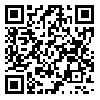year 3, Issue 1 (Vol.3, No.1, Autumn-Winter 2019)
JIC 2019, 3(1): 11-26 |
Back to browse issues page
Download citation:
BibTeX | RIS | EndNote | Medlars | ProCite | Reference Manager | RefWorks
Send citation to:



BibTeX | RIS | EndNote | Medlars | ProCite | Reference Manager | RefWorks
Send citation to:
azam kasiri A. A Comparative Study of the Visual Elements in Five Miniatures of the Prophet’s Ascension . JIC 2019; 3 (1) :11-26
URL: http://jih-tabriziau.ir/article-1-64-en.html
URL: http://jih-tabriziau.ir/article-1-64-en.html
teacher's training university of shahid rajaee , atoosakasiri@gmail.com
Abstract: (9590 Views)
The epistles of the nocturnal ascent are some versified or prosaic narrations deal with the Ascension orspiritual journey of the Prophet and his observations and levels in this Divine way. According to their cultural traditions and religious beliefs, the Iranian Muslim painters as well as the Persian poets and writers have illustrated this story and prepared several painted manuscripts. Some of these valuable editions are still protected in collections and museums. According to cultural characteristics of each era, any of these versions shows unique different characteristics beside similarities. This research attempts to dedicate the specifications of the visual elements and signs of each era through a comparison among five paintings in different versions of this narration_ Meraj-name of Ahmad Mussa and a miniature of Jami-al-tawarikh Rashidi from Ilkhanid period, Meraj-name of Shahrokh from Timurid era, a picture of the prophet’s nocturnal ascension in Khamseh of Tahmasp from Safavid school and the Ascension painting of Mahmoud Farshchian as a representative of Iran’s modern age. Through qualitative research and descriptive-analytical methodology, this research is going to compare between five different styles of pictorial description in five miniature masterpieces. And according to this study, the article shows the different cultural symbols, signs and elements of Iranian religious illustration in several periods. The main results of this article explain the similar or different rules of these eras’ visual culture for the embodiment of the sacred icons, other contents, colors and compositions, symbols for illustrating sacred character, clothing of the actants of the pictorial narration and other accessories of visual narrative. Some of these specialties and principles include: Drawing light halo around prophet’s head and covering his face in most of cases except for miniatures of Mongolian and Timurid period because of the Chinese cultural influences. Both horizontal and vertical compositions are used in all periods. And in Safavid and new picture of Meraj painted by contemporary artist Farshchian, round composition and golden spiral can be seen beside a new point of view for depicting the characters. Moreover some colors have been used as a symbol for wisdom and virtue like blue or green. Older paintings are more emotional in colors and more realistic in drawing style and later miniatures are mostly metaphorical and abstract in their style of coloring and illustrating the visual elements. The characteristic of angles in miniatures are female-like and humanistic in their cloth design and faces. In Ascension paintings the sky is golden or red or blue, sometime full of stars and angels to show the holiness and greatness of the visual narration. Furthermore the stars and the moon in sky are symbols for unity in diversity. In most pictures the Prophet’s transporter is Boraq who is a spiritual creature with horse body, cow tail and human face; Except for the painting in Meraj-name of Ahmad Mussa in which Gabriel the Archangel is the one who carries the Prophet on his shoulder. The movement in figures defer in every case, from right to left, from left to right, from deep to surface or from surface of the picture to deep.
Type of Study: Original Research |
Subject:
2
Received: 2018/03/13 | Accepted: 2019/08/25 | Published: 2019/09/16
Received: 2018/03/13 | Accepted: 2019/08/25 | Published: 2019/09/16
Send email to the article author
| Rights and permissions | |
 |
This work is licensed under a Creative Commons Attribution-NonCommercial 4.0 International License. |




 tabriziau.ac.ir
tabriziau.ac.ir